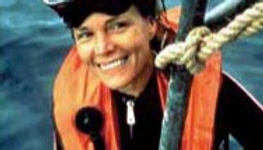Sylvia Reade Earle (born 1935)
Oceanographer
Time Magazine’s First Hero for the Planet

Connie Wolfman
Fri Apr 01 2022 07:00:00 GMT+0000 (Coordinated Universal Time)
Oceanographer and explorer Sylvia Earle has logged more than 7,000 hours underwater. She was the first woman to hold the position of chief scientist at the National Oceanic and Atmospheric Administration, and in 1998 Time Magazine named her their first Hero for the Planet. Today Earle is considered one of the world’s leading authorities on marine ecosystems, specializing in the development of new technologies for effective exploration of the deep sea.
As a student at Florida State University, Earle became a certified scuba diver in order to study aquatic plant- life, and in 1966 she earned a PhD in botany from Duke University.
Earle began her career as director of the Cape Haze Marine Laboratory in Florida. In 1970, she was tapped to lead the first all-female team of aquanauts in the Tektite II experiment, an installation of structures 50 feet below the water’s surface in the US Virgin Islands, which was designed to test the viability of prolonged underwater living.
During an untethered dive to the ocean floor near Oahu in 1979, Earle set a depth record of 1,250 feet that still stands today, earning her the nickname “Her Deepness.” That year she also became curator of phycology at the California Academy of Sciences.
In 1982, Earle founded Deep Ocean Engineering with British engineer Graham Hawkes, who later became her third husband. Their engineering team designed and built the Deep Rover research submarine, which can operate at a depth of 3,300 feet.
Earle has been a National Geographic Explorer-in-Residence since 1998, a designation that offers funding and support for exceptional individuals who protect the world through their work in science, exploration, and education. She received the million-dollar TED prize In 2009, which allowed her to launch Mission Blue, an organization that has created 122 marine-protected areas (dubbed “Hope Spots”) around the globe.



